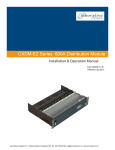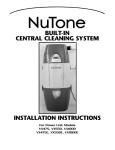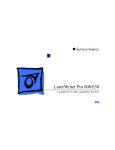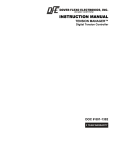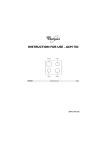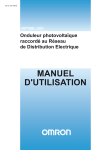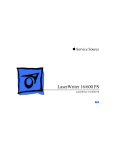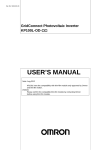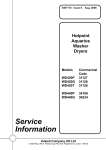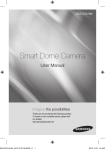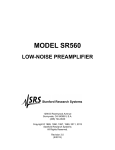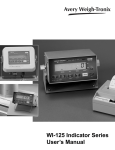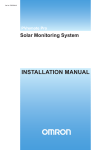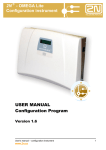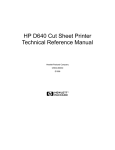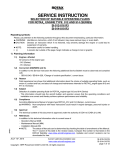Download Laserjet 4 and 5 series Troubleshooting process
Transcript
7 LaserJet 5 Error Map The LaserJet 5/5M/5N printer has error messages that are similar to the LaserJet 4/4M/4+/4M+. Use the following table to look up the LJ5 error and take the recommended action. If the recommendation is to see another error, for example See 00 POWERSAVE, look up the recommendation for that error in the Printer Message Troubleshooting section (Tables 7-1 and 7-2). Note The LaserJet 5 printer’s Go key replaces both the Online and Continue keys previously used to resolve some of the temporary errors in the LaserJet 4 and 4 Plus printers. Note For any LaserJet 5 error message preceded with a number from 20 through 81, look up the equivalently-numbered message in Table 7-1 and proceed as directed. Message on LJ 5/5M/5N Recommendations CLEARING MEMORY See 07 RESET CLOSE PRINTER COVER See 12 PRINTER OPEN CONTINUOUS TEST, PRESS JOB CANCEL KEY See 04 SELF TEST DATA RECEIVED The received data is waiting for a form feed. (Takes the place of the Form Feed indicator on the LJ4.) ENGINE TEST See 15 ENGINE TEST FACTORY DEFAULTS BEING RESTORED See 09 MENU RESET INCOMPATIBLE ENVELOPE FEEDER INSTALLED Indicates that an envelope feeder has been installed that is not compatible with the LJ5. Press GO to clear the error. The feeder will not appear in any control panel or PJL messages. LaserJet 5 Error Map 7-A Message on LJ 5/5M/5N Recommendations INCOMPATIBLE TRAY 3 INSTALLED Indicates that a lower cassette has been installed that is not compatible with the LJ5. Press GO to clear the error. The tray will not appear in any control panel or PJL messages. INITIALIZING (powerup only) See 05 SELF TEST INSTALL TONER CARTRIDGE See 14 EP CART INSTALL TRAY 2 See PC INSTALL INSUFFICIENT MEMORY, JOB CLEARED See W3 JOB ABORTED INSUFFICIENT MEMORY, PRINTING AT 300 DPI See W4/7 JOB 300/[page protect size] MANUALLY FEED [envelope size] See ME FEED [envelope size] MANUALLY FEED [paper size] See MF FEED [paper size] MEMORY LOW, PAGE SIMPLIFIED See W1 IMAGE ADAPT MEMORY SETTINGS CHANGED See WM MEM CNFIG N/A or WM CHK MEM CNFIG OFFLINE See 00 OFFLINE [personality] MEMORY FULL, STORED DATA LOST See PLEASE WAIT This message is displayed whenever the device is in the process of flushing the pipeline so it can go offline or into the menus. (Takes the place of the flashing Online indicator.) POWERSAVE ON See 00 POWERSAVE PRINTING CONFIGURATION PAGE See 05 SELF TEST / 06 PRINTING TEST PRINTING DEMO PAGE See 06 DEMO PAGE PRINTING FLASH PAGE This message is displayed while a flash file system page is being formatted and printed. Upon successful completion, the device returns to an online and ready state. PRINTING FONT LIST See 06 TYPEFACE LIST PROCESSING JOB This message is displayed whenever the device is actively processing a user’s job. (Takes the place of the flashing Ready indicator.) READY See 00 READY REMOVE DUPLEX JAM See 13 DUPLEX JAM 7-B LaserJet 5 Error Map WM [Personality] MEM FULL Message on LJ 5/5M/5N Recommendations REMOVE PAPER JAM See 13 PAPER JAM REQUESTED LANGUAGE NOT AVAILABLE See W2 INVALID PERS RESETTING ACTIVE I/O See 07 RESET RESETTING ALL I/O See 07 RESET RESTORING FACTORY SETTINGS See 08 COLD RESET TONER LOW See 16 TONER LOW TRAY 2/3 EMPTY Indicates Tray 2 or 3 has run out of paper and has not been selected as the current job’s paper source. If the problem persists, check for a binding sensor flag or replace the appropriate sensor. TRAY x LOAD [paper or envelope size] See xx LOAD [paper or envelope size] WARMING UP See 02 WARMING UP x LOAD [envelope size] x=Tray 1 or Envelope Feeder See xx LOAD [paper or envelope size] LaserJet 5 Error Map 7-C 7-D LaserJet 5 Error Map 7 Troubleshooting Pre-Troubleshooting Procedures Preliminary Operating Checks Prior to troubleshooting a specific printer problem, you should ensure that: • The printer is being maintained on a regular basis as described in Chapter 4. • The customer is using acceptable media as specified in the User’s Manual. • The printer is installed on a solid, level surface. • The line voltage does not vary more than 10% from the nominal rated value as specified on the Power Rating Label. • The operating environment for the printer and paper is within • • • the temperature and humidity specifications listed in Chapter 1 of this manual. The printer is never exposed to ammonia fumes such as those produced by diazo copiers, or office cleaning materials. The printer is not exposed to direct sunlight. Non-HP components (such as refilled toner cartridges, font cartridges, and memory boards) are removed from the printer. Troubleshooting 7-1 Printer Message Troubleshooting Printer Message Summary Table Table 7-1 is a list of all status, attendance, error, and service messages affecting the printers. The table also identifies the action required to correct the situation identified by the message. When the action requires removal and replacement of an assembly or PCA, refer to the applicable section of Chapter 6 for instructions. For general location of components, refer to Troubleshooting Aids at the end of this chapter. Table 7-1 Printer Messages Message Symptoms and Recommendations Blank Display Refer to the “Blank Display” Table 7-3. 00 READY Proceed; printer is ready to use. 00 POWERSAVE POWERSAVE ON Printer is in Power Save Mode. Press any key to take printer out of Power Save mode. Receipt of data or an error condition will also take printer out of Power Save mode. The job will print when the fuser is warmed up (may take up to 45 seconds). 00 OFFLINE Printer is off line and not able to receive data. Press On Line*. 02 WARMING UP Wait until printer signals ready. 05 SELF TEST The non-printing portion of Self Test is in progress. Wait for the printer to display the 00 READY message. 06 PRINTING TEST PRINTING CONFIGURATION PAGE Self Test printing. Wait for the printer to display the 00 READY message. 06 TYPE PRINTOUT Printing sample characters from available typefaces. Wait for the printer to display the 00 READY message. (Note: the format is different for PCL and PostScript.) 06 TYPEFACE LIST PRINTING FONT LIST Printing a Typeface List. (Note that PCL/Postscript formats are different.) 06 DEMO PAGE PRINTING DEMO PAGE Printing a Demonstration Page. (Note that PCL/Postscript formats are different.) 06 CONFIG PAGE Printing a Configuration Page. Appears only with PostScript installed in the printer. *Press Go on the LJ5. 7-2 Troubleshooting Table 7-1 Printer Messages (continued) Message Symptoms and Recommendations 07 RESET RESETTING [xxx] Returns all printer settings to Printing Menu settings, and clears buffered pages, temporary soft fonts, and macros. Wait for the printer to display the 00 READY message. See the Reset Menu section in Chapter 3 for more details. 08 NVRAM_INIT Printer is initializing non-volatile RAM. This allows other personalities to access non-volatile RAM. 08 COLD RESET Returns both Configuration and Printing Menu selections to the factory settings. Ensure that the Configuration Menu settings are correct before placing the printer on-line. Wait for the printer to display the 00 READY message. See the Reset Menu section in Chapter 3 for more details. RESTORING FACTORY SETTINGS RESET=MENU 09 MENU RESET 09 RESET ACTIVE I/O 09 RESET ALL I/O FACTORY DEFAULTS BEING RESTORED Follows a Control Panel [Reset] selection. The printer returns all Printing, PCL, PS, and Job Menu items to the factory settings. Clears buffered page data, temporary soft fonts, and temporary macros. See Chapter 3 for more details. 10 RESET TO SAVE The Printing, PCL, PS, and Config Menus were changed while data, temporary fonts, or temporary macros were present in printer memory, or while the printer was in the middle of a job. Press [Continue]* or [On Line]*. Your changes remain recorded in the menu but do not become active until the printer is reset, or the job boundary is detected. 12 PRINTER OPEN CLOSE PRINTER COVER Close the Top Cover Assembly. If the problem continues, refer to the “12 PRINTER OPEN Message” section. 13 PAPER JAM REMOVE PAPER JAM Open printer and clear any paper within the printer. Press [Continue]* or [On Line]* to reprint the page. If the problem persists, refer to “13 PAPER JAM Message” section. 13 DUPLEX JAM REMOVE DUPLEX JAM Check for any paper in the Duplexer area. If problem persists, refer to the Duplex Section (Appendix A). 14 NO EP CART Ensure that the Toner Cartridge is installed correctly (fully seated into the printer). Try a new Toner Cartridge. If the problem continues, refer to the “14 NO EP CART Message” section. INSTALL TONER CARTRIDGE 15 ENGINE TEST This message is displayed during the execution of a print engine self-test. When this test is complete, the printer returns to the ready state, but remains off line. 16 TONER LOW The toner cartridge is almost empty. Replace the Toner Cartridge. Although you can continue to print for a short while, make sure that the print quality does not degrade past the acceptable level. If the problem continues, refer to “16 TONER LOW” Message" section. *Press Go on the LJ5. Troubleshooting 7-3 Table 7-1 Printer Messages (continued) Message Symptoms and Recommendations 18 AUX IO INIT This message is displayed when the MIO (AUX IO) card is in the process of initializing. During initialization the MIO is not active, but since the printer supports I/O switching, the printer remains on line and this becomes a status message. Display clears automatically (this may take up to a minute, depending upon the card). 18 AUX IO NT RDY The MIO (AUX IO) card is not ready. See the user’s manual for the MIO card. The serial and Bi-Tronics parallel ports continue to operate normally. To clear the display, you must remove the card, and power-cycle the printer. The [Continue]* key does not clear the display. 18 MIO INIT The MIO card is initializing. This is a status message. During initialization the MIO is not active, but since the printer supports I/O switching, the printer remains on line. Displays clears automatically (may take up to a minute, depending on the card). 18 MIO NOT READY The MIO card is not ready or not connected to a working network. The serial and Bi-Tronics parallel ports will continue to operate normally. To clear the display, switch the printer OFF, remove the card and switch printer ON. [Continue]* will not clear the display. See MIO documentation for troubleshooting. 20 MEM OVERFLOW Indicates a memory overflow. Too much data is being sent to the printer and the printer has run out of memory. Pressing the [Continue]* key causes the printer to print only the information it received. If the error persists, it may be necessary to simplify the print job (such as fewer fonts and less graphics information), or have the customer purchase additional memory. 20 INSUFFICIENT MEMORY 21 PRINT OVERRUN 21 PAGE TOO COMPLEX Indicates that the information being sent to the printer is too complex for the printer (the formatting capabilities of the printer cannot keep up with the formatting instructions being sent to it by the computer). If the error persists, it may be necessary to simplify the job (reduce the number of characters, number of fonts used, number of pixels addressed, cursor repositions, or reduce addressing the same pixel location multiple times). This problem can also be resolved by adding at least one additional memory PCA, and setting PAGEPROTECT=[LTR, LGL, or A4], if applicable. *Press Go on the LJ5. 7-4 Troubleshooting Table 7-1 Printer Messages (continued) Message 22 ERROR 22 SERIAL I/O ERROR 22 PARALLEL I/O ERROR 22 HP MIO ERROR 40 ERROR 40 BAD SERIAL DATA FORMAT 40 HP MIO ERROR Symptoms and Recommendations For serial/Bi-Tronics parallel configuration, the computer and printer are not communicating because of improper signal protocols. This is an I/O buffer overrun error. Parallel configuration: may mean a loose cable connection. Serial configuration: wrong pacing option may be selected. (If you are using an RS232 serial connection, the HP LaserJet printer uses XON/XOFF and DTR signal protocols rather than ENC/ACK protocol.) Press [Continue]* to clear the error message (data is lost). The printer encountered an error while transferring data from the computer. For serial I/O configuration, the error may have occurred because you turned ON or OFF your computer while the printer was on line, or your printer’s baud rate or parity was not the same as the computer’s. For network MIO cards, this means there was an abnormal connection break. Make sure the printer is set at the same baud rate as the computer. Press [Continue]* to clear the error message. For network MIO cards, see the user’s manual for your card. 41.[X] ERROR 41.x PRINTER ERROR x=1, 2, 4 ,5 A temporary error occurred while printing. Press the [Continue]* key to clear the error. If the error persists, refer to “41.X ERROR Message.” 41.3 ERROR 41.3 UNEXPECTED PAPER SIZE The paper size selection knob or MP paper size does not match the installed paper or more than one sheet of paper was picked up. 50 SERVICE 50 FUSER ERROR Power OFF the printer for a minimum of 10 minutes. If the problem continues, refer to the “50 SERVICE error” section. 51 ERROR Indicates loss of laser beam for over 2 seconds. Press [Continue]* to clear this error. If the error persists, refer to the “51 ERROR Message” section. 51 PRINTER ERROR 52 ERROR 52 PRINTER ERROR Indicates scanner motor is unable to maintain the proper speed. Press [Continue* to clear this error. If the error persists, refer to the “52 ERROR Scanner Malfunction” section. *Press Go on the LJ5. Troubleshooting 7-5 Table 7-1 Printer Messages (continued) Message 53.XY.ZZ ERROR Symptoms and Recommendations An error occurred during configuration and validation of SIMM memory: X Hardware Type: 0:ROM 1:RAM 2:Flash Y Hardware Device: 0: Internal Memory 1: SIMM Slot 1 2: SIMM Slot 2 3: SIMM Slot 3 4: SIMM Slot 4 ZZ Error Number: 0: Unsupported Memory 1: Unrecognized Memory 2: Unsupported Memory Size 3: Failed RAM Test 4: Exceeded Maximum RAM Size 5: Exceeded Maximum ROM Size 6: Invalid SIMM Speed 7: SIMM Reporting Information Incorrectly 8: SIMM RAM Parity Error LaserJet 4/4m only 9: SIMM ROM Needs To Be Mapped To An Unsupported Address 10:SIMM Address Conflict 11:PDC XROM out of bounds 12:Could not make a temporary mapping Replace the SIMM device that caused the error. Pressing [Continue]* allows you to continue but the SIMM device that caused the error is not configured. If the SIMM device has more than one bank of memory, the good banks are configured. *Press Go on the LJ5. Note Refer to the “Product Family Compatibility Matrix” in Chapter 1, or for the LaserJet 5, Appendix B to verify correct memory for the printer. 7-6 Troubleshooting Table 7-1 Message 55 ERROR 55 PRINTER ERROR Printer Messages (continued) Symptoms and Recommendations Indicates a communications problem between the DC Controller PCA and the Formatter PCA. Pressing [Continue]* clears the error and resumes printing. Perform the Test Print operation to verify DC Controller functionality. If the message persists, check for any cable damage, and check the DC voltages, or replace the DC Controller. 57 SERVICE 57 MOTOR FAILURE 57.1 SERVICE This message indicates that a main motor failure occurred. Power cycle the printer. If the error persists, first check the connections at the main motor and DC Controller, then replace the main motor to clear the error. See “57 (or 57.1) SERVICE message. 58 SERVICE This errors indicates the DC Controller detects an exhaust 58 FAN MOTOR FAILURE fan failure in either the printer or the optional duplexer. See 57.2 SERVICE the “58 (or 57.2) SERVICE” section for more information. 61.[x] SERVICE X=0 - 4 Printer encountered a parity error when accessing the RAM memory SIMM in slot “X”. If X=0, the faulty SIMM slot was not detected. Turn OFF the printer, then back ON. (Data stored in printer is lost.) If the error is still present, Turn OFF the printer and verify that the indicated SIMM is correctly installed. Turn ON the printer . If the error is still present, turn OFF the printer, and remove the SIMM board. Turn ON the printer. If the error message does not appear, the problem is on the SIMM board; if the error still appears, the problem is in the printer’s internal memory. 62.[x] SERVICE x=0 - 5 Printer identified a problem while checking its memory. “X” refers to the device the printer was checking when it encountered the error. 0: Internal Memory 1-4: SIMM Slot 5: Cartridge If the printer contains a SIMM memory board, turn OFF the printer. (Data stored in printer is lost.) Verify that the SIMM is installed correctly, and turn ON the printer. If the error is still present, turn OFF the printer, and remove the SIMM board. Turn ON the printer. If the error message does not appear, the problem is on the SIMM board. 63 SERVICE 63 NEEDS SERVICE The printer found a problem in its internal RAM memory. Switch OFF the printer, and then switch ON. (You lose any data stored in the printer.) If the problem persists, replace the Formatter PCA. *Press Go on the LJ5. Troubleshooting 7-7 Table 7-1 Printer Messages (continued) Message 64 64 65 67 SERVICE PRINTER ERROR SERVICE SERVICE Symptoms and Recommendations The printer identified an internal service error. If this error appears, turn the printer OFF, and then back ON. If the problem persists, replace the Formatter PCA. 68 ERROR 68 NVRAM ERROR The printer detected an error in the nonvolatile memory (NVRAM). Press [Continue]*, then check your Control Panel settings. If the problem persists, replace the Formatter PCA. 68 SERVICE 68 NVRAM FULL The printer’s nonvolatile memory is full because new feature sets were installed. Power the printer OFF, then back ON. If the problem persists reinitialize the NVRAM by pressing the [Item]** key while powering on the printer. Reset the page count, cold reset paper size, display language, and all other applicable control panel settings. 70 SERVICE HP LJ 4+/4M+ Only A firmware SIMM problem was identified. Remove or replace the firmware SIMM. 71 SERVICE HP LJ 4+/4M+ Only A firmware SIMM problem was identified. Remove or replace the firmware SIMM. 79 SERVICE [xxxx] An internal controller error has occurred. Power the printer OFF, then back ON. If this error persists, replace the Formatter PCA. Remove third party memory, if installed. May also be caused by driver or application incompatibilities, or defective toner cartridge. 80 SERVICE [xxxx] The formatter PCA has been informed of an irrecoverable error by the MIO card. Power cycle the printer. If the error persists, replace the MIO card. 81 SERVICE [xxx] Formatter manufacturing error. Cold Reset the printer. If the problem persists, replace the Formatter PCA. EE LOAD [envelope size] The printer received a request for an envelope size that is not loaded currently in the optional envelope feeder, or the feeder is empty. Envelope size may be: COM10, MONARCH, or DL, C5, B5, or ENVELOPE. Load the correct envelope size into the tray, or press [Continue]* to use the size of media installed in the feeder. ENVELOPE FEEDER [envelope size] FE CARTRIDGE An accessory cartridge was removed or replaced while the printer was on line. (This message appears even if the cartridge was not used.) Power cycle the printer to clear this message. Ensure that the printer is off line when the cartridge is removed or installed. If a font cartridge is not recognized, verify that it is installed correctly. FI INSERT CART An accessory cartridge was removed while the printer was in an error state. To clear this message, insert the cartridge, clear any error conditions, then remove the cartridge. *Press Go on the LJ5. **Press Job Cancel on the LJ5. 7-8 Troubleshooting Table 7-1 Printer Messages (continued) Message Symptoms and Recommendations FR REMOVE CART An accessory cartridge was installed while the printer was in an error state. To clear this message, remove the cartridge, clear the pending error condition, then install the cartridge. ME FEED [envelope size] MANUALLY FEED [envelope size] This message is displayed when there is a request for a manually fed envelope. envelope size may be: COM10, MONARCH, DL, C5, B5, or ENVELOPE. Insert the appropriate envelope size into the MP tray (Tray 1), and press [On Line]* to print. MF FEED [paper size] This message is displayed when there is a request for manually fed media. Paper size may be: LETTER, LEGAL, EXEC, or A4. Insert the appropriate media size into the MP tray, and press [On Line]* to print, or press [Continue]* to feed from the Paper Cassette (Tray 2). MANUALLY FEED [paper size] PC INSTALL INSTALL TRAY 2 xx LOAD [paper size or envelope size] TRAY x LOAD [size] ENVELOPE FEEDER [envelope size] The printer currently has the Lower Cassette or duplexer selected as the paper source, and has detected that the Paper Cassette (Tray 2), which serves as a paper guide for the Lower Cassette, is not installed. Install (reseat) the Paper Cassette. The printer received a request for a paper or envelope size not available in the printer. The xx is MP (Multi-Purpose), PC (Paper Cassette), or LC (Lower cassette). Paper size may be: LETTER, LEGAL, EXEC, or A4; for MP tray, envelope sizes may be COM10, MONARCH, DL, C5, or B5. Load the correct paper tray and/or media, or press [Continue]* to use the media in the installed tray(s). The printer continues automatically. If the problem persists, refer to page 7-13. *Press Go on the LJ5. Troubleshooting 7-9 Clearable Warnings A clearable warning indicates a transient condition in the printer. The printer continues on line while the message is displayed in place of 00 READY. A clearable warning appears each time the printer alters resolution or page protection (this causes reconfiguration of memory), or aborts a job due to an invalid or uninstalled personality, or insufficient memory. Clear the message by pressing [Shift] + [Continue] (or Go for the LaserJet 5). 7-10 Troubleshooting Table 7-2 Clearable Warning Messages Message Displayed W1 IMAGE ADAPT MEMORY LOW, PAGE SIMPLIFIED Meaning The printer received a graphics print file that was too complex to print at the requested resolution. The printer automatically processed the file in the highest resolution possible with the memory installed. Add additional memory to print the file at full resolution. Check the printout for loss of data or print quality. REQUESTED LANGUAGE NOT AVAILABLE The job was not printed because the requested personality, such as PostScript, was not installed. Install the language in which the files are sent, together with enough memory to support that language. W3 JOB ABORTED INSUFFICIENT MEMORY JOB CLEARED The printer was forced to abort the print job because there was not enough installed memory to support the printer language used. W4 W5 W6 W7 300/OFF 300/LTR 300/A4 300/LGL The job was printed at 300 dpi with page protection set as specified in the message. To print the job as requested, install additional memory. W8 JOB 600/OFF W9 JOB 600/LTR W0 JOB 600/A4 The job was printed at 600 dpi with page protection set as specified in the message. To print the job as requested, install additional memory. WM MEM CNFIG N/A The printer did not have enough memory when switched on to support the previous settings for I/O buffering and /or Resource Saving, probably because you removed a memory SIMM, added a new personality SIMM, or added the optional duplex unit. W2 INVALID PERS JOB JOB JOB JOB MEMORY SETTINGS CHANGED WM CHK MEM CNFIG MEMORY SETTINGS CHANGED WM [personality] MEM FULL [personality] MEMORY FULL I/O Buffering and /or Resource Saving settings were altered when the printer was switched on because the printer did not have enough memory. This usually occurs after memory has been removed from the printer. (You can check settings by printing a self test.) The Resource Saving memory area for the specified personality is full. Press [CONTINUE]* to continue printing (some data will be lost). The current job will print, but some resources (downloaded fonts, etc.) may not be saved. If this error occurs frequently, you may need to adjust Resource Saving settings. *Press Go on the LJ5. Troubleshooting 7-11 Printer Message Troubleshooting Procedures When the following procedures require removing and replacing an assembly or PCA, refer to the applicable section in Chapter 6 for instructions. Blank Display Table 7-3 Blank Display Checks Is the power on? Action 1. Check the ON/OFF switch and verify the power is plugged in. 2. Press a Control Panel key to verify problem still exists. Is the fan working? 1. If the fan is working, check the cabling to the Control Panel. If the cabling is good, replace the Formatter first, then the Control Panel. 2. If the fan is NOT working, measure the DC voltage levels (refer to Table 7-39). If the voltage levels are good from the power supply to the DC Controller and the fan is not working, replace the DC Controller. If the voltage levels are not present at TB1, replace the DC Power Supply. 7-12 Troubleshooting MP/PC/LC (Tray 1/2/3) LOAD Message The conditions that result in MP/PC/LC LOAD or (TRAY 1/2/3) messages are: • The absence of any input tray. • The absence of media in either tray. • The tray size switches may be defective and not recognize • the presence of the paper tray. The tray is sensed as the tray-identifier tabs contact one or more of the three tray identifier microswitches. The Universal Tray paper size dial setting does not match the installed paper. The MP/PC/LC LOAD message is also generated when the user or software requests a paper size other than that installed. The Paper Sensing Arms are located in the paper input areas of the printer. During normal operation, the Paper Sensing Arm flags rest on the media installed in the paper tray. The Sensing Arm flags are attached to shafts. The opposite end of the shaft is a photointerrupter that rotates through the sensors on the Paper Control PCA. These sensors are: • PS4 Paper out-MP tray. • PS2 Paper out-PC tray. • PS6 Paper out-Lower Cassette. • PS7 Paper out-Envelope Feeder. The presence of paper in the paper tray is sensed by the paper sensor arm. When paper is in the cassette, the sensor arm rests on top of the paper in the tray. At this point, the sensors are not blocked. When the tray is empty, the arm swings through its travel. The photointerrupter attached to the paper sensor arm shaft rotates and blocks the sensor diode. Troubleshooting 7-13 Table 7-4 “MP/PC/LC (Tray 1/2/3) LOAD” Message Checks Checks Action Is media present in the tray(s). Install media. Are the proper trays fully inserted in the printer? Reseat the cassettes. Make sure each cassette is fully seated into the printer. Ensure that the Universal Paper tray selector knob setting matches the installed paper. Does the Control Panel’s or application’s Paper size setting match the tray being used? Correct the setting to match tray. Is the expected tray size being recognized by the printer? Ensure that the image is sized correctly (formatted) for the paper size selected. Proceed to the following cassette size switches functional check. Check switches 603/4/5 if feeding from the PC tray (Tray 1). Check switches 851/2/3 if feeding from the Lower Cassette. see Figures 7-14 and 7-15 for locations.) Are any of the tray identifier tabs broken on either PC (Tray 1) or LC (Tray 2) paper tray? Inspect the tray for damage. If damaged, replace the tray. 7-14 Troubleshooting Cassette Size Switches (SW603, SW604, SW605) Functional Check Before beginning this test, remove the Lower Cassette Base and the Envelope Feeder. Also, PS2 (PC or Tray 2 Paper Out sensor) must be engaged for this test to be performed reliably. Push PS2 up towards the rear of the printer with your hand. 1 Power ON the printer with the PC tray removed. Wait for the PC LOAD XXX message. Set PAPER=LETTER in the Printing Menu using the Control Panel. 2 With PS2 engaged, press and hold the lower and upper paper size switches (refer to Table 7-5). The display should read 00 READY. If the display does not change, the switches are defective. Inspect the switch activating mechanism and/or replace the Paper Control PCA. 3 Repeat the test, this time setting the paper size to legal (PAPER=LEGAL) and pressing the top two switches. If the printer responds with 00 READY, all three switches have been tested and verified. Note The LaserJet 5 printer will require you to set the paper size, followed by a self test to generate the equivalent TRAY 2 LOAD message. Use the Job Cancel key between tests to cancel the Self Test printout. Figure 7-1 PC Tray Size Sensing Microswitches Location Troubleshooting 7-15 Table 7-5 Switch Logic for Cassette Size Cassette Cassette Size Sensing Switch SW603/851 SW604/852 SW605/853 Upper Middle Lower Legal ON ON OFF Letter ON OFF ON A4 OFF OFF ON Executive OFF ON ON No Cassette OFF OFF OFF Paper Size Sensing Lower Cassette The operator must set the appropriate paper size for the Lower Cassette using a dial which, in turn, activates switches on the cassette base. This setting is sent to the DC Controller on the serial data bus (SLI). The printer posts a 41.3 SERVICE error if the media is different from that selected with the switch. To verify proper operation of the LC (Tray 3) switches, lock out the MP (Tray 1) and PC (Tray 2) trays (in the Config Menu) and perform the same test with Lower Cassette switches as was done for the PC tray (Tray 2) switches. 7-16 Troubleshooting PC Empty Sensor (PS2) Functional Check 1 Power on the printer with the PC tray (Tray 2) empty. 2 After the 05 SELF TEST and the 02 WARMING UP cycles, the PC LOAD LETTER (or A4) or TRAY 2 EMPTY message appears. 3 Add paper to the PC tray and re-install the tray. 4 The display should read 02 WARMING UP, then 00 READY. If the PC LOAD or TRAY 2 EMPTY message persists, replace PS2. PS4 Check (MP Tray Empty Sensor) 1 With the printer powered ON and 00 READY displayed, select the Config Menu from the Control Panel. 2 Configure the MP Tray (Tray 1) as a cassette (MP TRAY=CASS or TRAY 1=CASSETTE). 3 Lock out the remaining paper trays (LOCK= PC LC or LOCK TRAY= 2 3). 4 Remove any paper from the MP Tray (Tray 1). The printer should display an MP LOAD [paper size] message. For the LaserJet 5 printer, run a Self Test to generate the TRAY 1 LOAD message. 5 Insert paper into the MP Tray (Tray 1). If the MP LOAD (TRAY 1 LOAD) message persists (or if the load message never occurred), PS4 or the sensor flag is defective. Troubleshooting 7-17 12 Printer Open Message The 12 PRINTER OPEN (or CLOSE PRINTER COVER) display tells the operator to close the printer’s top cover. The DC Controller detects the Printer Open condition through the position of SW601, which is located on the Paper Feed Assembly PCA . A tab underneath the top cover Door engages SW601 through a slot in the Top Cover Assembly. In addition to signaling that the top cover is open, SW601 enables the +24B VDC which controls the high voltage for the printing processes, and the AC Voltage for the Fuser Assembly. Table 7-6 12 PRINTER OPEN Checks Checks Action Is the Top Cover Assembly open? Ensure the Top Cover Assembly is firmly closed, and that the protrusion that engages the switch actuator is not broken. With the top cover open, check that the switch actuator does engage the switch. Use a slim object to manually engage SW601. Listen for a definite “click” as the switch is engaged (see Figures 7-2 and 7-14). Has the Paper Control PCA on the Paper SW601 has an actuator that can be Feed Assembly been replaced? deleted during reassembly. Ensure that this actuator is installed correctly. Is the DC Controller PCA defective? 7-18 Troubleshooting Measure the 24 VDC on J201, pins 8 and 9 on the DC Controller (see Figures 7-16 and 7-17 for locations). If this 24 volts toggles as SW601 is activated, replace the DC Controller. If it does not, replace the Paper Control PCA or the cable. Also check J201-6 (DOPEN). This voltage should be 5 VDC when the printer is open, and 0 when the printer is closed. If not, replace the DC Controller PCA. SW601 Functional Check 1 Open the Top Cover Assembly. 2 The message 12 PRINTER OPEN (or CLOSE PRINTER COVER) should appear. 3 Close the top cover. The 02 WARMING UP message should appear. 4 If the messages do not occur, check the switch actuator (see Figure 7-2, callout 1) on the top cover, and check that the plunger that covers the switch is in place (see also Figure 7-14 for switch locations). 5 Replace the Paper Control PCA. Figure 7-2 Location of the Top Cover Closed (SW601) Actuator Troubleshooting 7-19 13 PAPER JAM Message Paper jams occur when paper fails to arrive at or clear the paper path sensors in the allotted time. Paper movement is monitored primarily by two paper sensors. These are described below and illustrated in Figure 7-3). 1 PS1, the Input/Registration Sensor, located in the Paper Feed Assembly. 2 PS3, Exit Sensor, monitors paper in the Fuser Assembly. Figure 7-3 PS1 and PS3 (Paper Path Sensors) & PS5 Paper End Sensor When troubleshooting paper jams, the door associated with the sensor must be opened and closed to clear the jam message. For instance, if PS3 (Exit Sensor) detected the paper jam, and the jam was cleared through a method other than opening the rear door, the message remains in the display until the rear door is opened and closed. Likewise, the top cover must be opened before a jam detected by PS1 is cleared. The DC Controller monitors these sensors, and detects both the leading and trailing edge of the paper to verify that the paper clears the sensors in the allotted time. If the paper does not arrive at, or clear the sensors in the allotted time, the DC Controller senses a paper jam. The paper jam information is transferred to the Formatter PCA, which displays the 13 PAPER JAM message. Note also that if PS5 (MP Tray or Tray 1) Paper End Sensor on the Sensor PCA is bad (Figure 7-3, item 3), a paper jam will be reported when paper is fed from the MP Tray (or Tray 1). 7-20 Troubleshooting Table 7-7 Jam Location Input Area Jams (Sensed by PS1.) Paper Jam Troubleshooting Checklist Checks and Action Required 1. Check that the Transfer Roller is fully seated and shows no sign of wear. 2. Check that the Toner Cartridge is fully seated. 3. Check that the cassettes are not overfull and the media is loaded correctly. 4. Ensure that the media meets specs. (media is not too smooth or rough), and it has been stored properly. 5. Ensure that the paper tray is fully seated (especially if printing from the Lower Cassette). 6. Ensure that the spring force of the Lower Cassette is set correctly. Registration Area Jams (Sensed by PS1.) 1. If paper is damaged at the Registration Sensor (PS1), check that the Transfer Charge Roller is properly seated. Lower Cassette Paper Jams (Sensed by PS1.) 1. The LC Tray (Tray 3) is not fully seated into the printer. Seat the LC Tray firmly into the printer. Fuser Assembly Jams (Sensed by PS3.) 1. Check that the Fuser Pressure Roller Levers are down (LJ4 and 4 Plus Only). False Paper Jams 1. PS1, PS3, or PS5 are damaged or mechanically broken. 2. The Lower Cassette feed pressure (spring force) adjustment is incorrect. Set the spring force as shown in Chapter 3. 2. Check that the Exit Sensor Arm (PS3) is free throughout its travel and that the Exit Sensor Arm is installed correctly. 2. The sensor wires are damaged or disconnected. 3. The rear door is open. Paper Jam occurs when the last sheet of paper is fed from the tray. 4. Paper out sensors in the paper tray or envelope feeder may be defective, or the sensor flags may be broken or missing. PS2 is the sensor for the PC Tray (Tray 2), PS4 is the sensor for the MP Tray (Tray 1), PS6 is the sensor for the LC Tray (Tray 3), and PS7 is the sensor for the Envelope Feeder. Troubleshooting 7-21 PS1 (Input/Registration Sensor) Check 1 Power ON the printer with the top cover open. Wait for the 12 PRINTER OPEN (or CLOSE PRINTER COVER) message. 2 Engage PS1 by taping it down. a For the LaserJet 5, install the toner cartridge. 3 Close the top cover. The 02 WARMING UP message should display. 4 After the fuser warms up, the main motor should turn on. 5 The 13 PAPER JAM message appears if the sensor is working correctly. 6 If the 13 PAPER JAM message does not appear, check that PS1 was fully engaged, then replace PS1. 7 Remove the tape from PS1, install the Toner Cartridge and close the top cover. 8 The display should change from 02 WARMING UP to 00 READY. If the 13 PAPER JAM message persists, replace PS1. Figure 7-4 PS1 Input/Registration Sensor 7-22 Troubleshooting PS3 (Exit Sensor) Check 1 Open the rear door (cover) of the printer. 2 The display should read 13 PAPER JAM (or REMOVE PAPER JAM) immediately after the door is opened. 3 Close the rear cover. The display should change from 02 WARMING UP to 00 READY. a If the 00 READY message does not appear, check that the rear door is not damaged, and the the door closes and latches properly. b If the PAPER JAM message does not appear, replace PS3. Pickup Motor Functional Test (M2) There is not a good method with which to access the test points around the Pickup Motor (M2) circuit. Therefore, when troubleshooting Pickup Motor failures, perform the following in the order listed (see Figures 7-11 and 7-12 for component location). 1 Reseat J601 and J602 on the Paper Control PCA. 2 Reseat J201 on the DC Controller. Reseat J703 on the Sensor PCA. 3 Verify that the Paper Control PCA and the Sensor PCA are firmly seated into one another. 4 Replace the Pickup Motor. 5 Replace the Paper Control PCA. 6 Replace the Sensor PCA. Troubleshooting 7-23 Lower Cassette Functional Check When troubleshooting a Lower Cassette failure, always prove the failure by removing the Lower Cassette from the printer. Next, test the printer’s ability to move and print media satisfactorily without the Lower Cassette installed. The Lower Cassette is a field-serviceable item. The procedures for removing and replacing the Lower Cassette components are in Chapter 6. Replacement parts for the Lower Cassette Assembly are listed in Chapter 8. After the failure has been associated with the Lower Cassette Assembly, perform the following in the order given. Test the repair after each replacement. 1 2 3 4 Reseat all connectors in Lower Cassette. Replace the Lower Cassette Pickup Motor. Replace the Paper Control PCA. Replace the DC Controller. 7-24 Troubleshooting 14 NO EP CART Message The printer detects the presence of the Toner Cartridge and the level of toner present in the cartridge through the condition of the ANTIN signal. The ANTIN signal becomes part of the serial data stream used to communicate with the DC Controller (see Figure 7-5 for cartridge components). Troubleshoot the 14 NO EP CART (or INSTALL TONER CARTRIDGE) message as follows: 1 Reseat the Toner Cartridge. Try a new or known good Toner Cartridge. 2 Check the High Voltage Contacts for damage. If the contacts are dirty or damaged, clean the contacts after the repair. 3 Replace the High Voltage Power Supply. 4 Check and reseat the HVPS cable. 5 Replace the DC Controller. 16 Toner Low Message The TONER LOW message results as the level of toner in the cartridge cavity falls past the minimum level. The level is sensed by a mechanism similar to an antenna, which detects the AC Developer Bias Voltage applied to the developer mixture. If the TONER LOW message cannot be cleared by shaking or replacing the Toner Cartridge, perform the steps listed for troubleshooting the 14 NO EP CART message. Troubleshooting 7-25 6 1 5 4 2 3 Figure 7-5 Toner Cartridge Components Table 7-8 Toner Cartridge Components Callout Assembly 1 Toner Low Voltage Contact 2 Developer Roller High Voltage Contact 3 Developer Roller 4 Photoconductive Drum 5 Charge Roller High Voltage Contact 6 Charge Roller 7-26 Troubleshooting 41.X ERROR Message A 41.X ERROR (misprint) indicates that a temporary malfunction has occurred with the print engine (NOT a Formatter error). Occasional occurrences of this message can be expected. However, persistent 41 ERROR messages indicate a problem requiring attention. The 41.X ERROR is usually accompanied by a blank, or partially printed page. Pressing the [Continue] (or Go) key re-prints the page, and continues the print job. A 41 ERROR occurs due to the following conditions: • Incorrect Universal Tray Switch setting. Set the Universal • • • Tray and the Lower Cassette Tray paper size as shown in Chapter 3. Wrong size paper in tray. Check that the Universal Tray, and/or the Lower Cassette settings match the installed paper. An unstable or temporary loss of the Beam Detect pulse. This problem normally is accompanied by a partially printed page, often with thin horizontal black lines, deformed characters, or solid black areas. Loss of the Beam Detect pulse for more than 2 seconds results in a 51 ERROR condition. Paper reaching the Input Paper Sensor (PS1) before it is expected. This is accompanied by a blank page. This normally is due to paper feed problems. Proceed as directed in the following table. Troubleshooting 7-27 Table 7-9 41.X ERROR Checks Error Message Recommended Action Reseat all connectors on the DC Controller, the Laser 41.1 ERROR Noisy Vertical Sync (VS) Drive PCA, the Scanner Connector and the Beam Detect Connector. 41.2 ERROR Beam Detect (BD) weak or unstable. Reseat all connectors on the DC Controller. Also check the Laser Scanning Assembly connections. 41.3 ERROR Paper Multifeed 1. Incorrect size selection on the cassette. 2. One of the cassettes is overfull. Remove the extra paper from the overfull cassette. 3. Check the paper for edge damage. Improperly cut edges can lock together causing multi-feeds. 4. Check that the pickup rollers and separation pad are not worn. Replace the rollers and pad as a set if necessary. Ensure that the corners of the paper are tucked in the tray’s retainers. 5. Check the paper tension adjustment on the optional Lower Cassette, if attached. Refer to procedure in Chapter 3. 41.4 ERROR Vertical Sync Late (VS) Signal Reseat the DC Controller and Formatter PCA Connections. 41.5 ERROR Undetermined Cause Reseat the DC Controller and Formatter PCA connections. See Figures 7-11 through 7-17 for connector locations. 7-28 Troubleshooting 50 SERVICE Error - Fuser Malfunction Warning The Fuser Assembly is HOT. Allow the assembly time to cool before servicing. The purpose of the fusing system is to maintain a constant temperature on the fuser roller. A high intensity fusing lamp, located inside the fuser roller, provides the high temperature required for the fusing process. While the printer is in standby mode, a temperature of approximately 172° C is maintained on the fuser roller. While the printer is in printing mode, a temperature of around 183° C is maintained. The main components of the Fuser Assembly are the fusing lamp and its associated fusing and pressure rollers, a thermistor, thermoprotector, and the AC controller/safety circuitry in the AC Power Supply. The fusing lamp is a specially designed 460 watt (220V), or 500 watt (115V) halogen lamp that operates at line voltage. The thermistor is a resistor whose value changes with temperature. At room temperature the resistance value of the thermistor should be between 180k ohms and 280k ohms.The thermoprotector is a switch designed for over-temperature protection, and opens when the temperature reaches 230° C. The thermoprotector will not reset when the fuser cools. It may be necessary to replace the thermoprotector or fuser assembly if the thermoprotector opens. The following conditions result in a fusing error: 1 Unable to maintain a temperature above approximately 180° C. 2 A temperature above 230° C. 3 A condition wherein a temperature of 165° C is NOT reached within 90 seconds after power-up. Note If a 50 SERVICE error message is displayed, turn the printer OFF for at least 10 minutes. Failure to wait the full 10 minutes before turning the printer ON results in a continuation of the error message and the shutting off of the fuser lamp current during this time, though the source of the error may have already been resolved. Troubleshooting 7-29 Table 7-10 50 SERVICE Fuser Malfunction Checks Checks Action Is the Fuser Assembly correctly seated? Reseat the Fuser Assembly. Allow adequate time for the error message to clear (10 minutes) and turn the printer ON. Is the Fuser Bulb/ Thermoswitch open? The fuser bulb and thermoswitch are wired in series. To check if one or the other is defective, perform the following: 1. Remove the Fuser Assembly from the printer. 2. Use an ohmmeter and measure the continuity between pins (see Figure 7-6, callout 1). It should read about 2 ohms (about 4 ohms for the 220 volt fuser). If an open condition is detected, either the fusing bulb or the thermoswitch is defective. Replace the defective component (refer to Chapter 6) or replace the complete Fuser Assembly. Is the Thermistor defective? 1. Remove the Fuser Assembly and let it cool to room temperature. 2. Use an ohmmeter and measure the resistance between pins (see Figure 7-6, callout 2) It should read about 220 K ohms +/- 40 K ohms at ambient room temperature. If the thermistor is either open or shorted, replace the thermistor (refer to Chapter 6) or the complete Fuser Assembly. Does the error persist? 1. Verify all cabling is correct. 2. Replace the following components in the order given: Power Supply Assembly DC Controller PCA See Figure 7-11 for Fuser Assembly location and Chapter 6 for removal and replacement, as necessary. Note The 50 SERVICE error message can be cleared immediately by shorting the C202 leads on the HP LaserJet 4/4M (or the C205 leads on the HP LaserJet 4 Plus/4M Plus/5/5M/5N) on the DC Controller. Remove the Formatter PCA to access the DC Controller as shown in Chapter 6. 7-30 Troubleshooting Figure 7-6 Fuser Assembly Connector 51 ERROR Message The 51 ERROR, and the 41.2 ERROR are caused by Beam Detect failures. If the beam detect signal is lost for more than 2 seconds the error is posted as a 51 ERROR. The 41.2 ERROR can be cleared by pressing [Continue] (or Go). The 51 ERROR may be cleared by power cycling the printer. Table 7-11 51 ERROR Beam Detect Checks Checks Action 1. Are all connectors on the DC Controller properly seated? Inspect connectors and wiring. Reseat or replace cables if necessary. 2. Is the Laser/Scanner Assembly Defective? A defective Laser/Scanner Assembly can cause a 51 ERROR by spinning the scanning mirror at the wrong speed. Replace the Laser/Scanner Assembly. 3. Is the DC Controller Defective? Replace the DC Controller. 4. Has the printer been moved from a cold to a warm room? Allow the printer to stand 6 hours until any condensation has dissipated. Troubleshooting 7-31 52 ERROR Scanner Malfunction The scanner motor is a flat, brushless, DC motor. Motor operation is completely controlled by the DC Controller. The scanner motor is enabled when the printer is powered-up (during the printer’s power-on self test), or whenever the PRINT command is received by the Formatter PCA. The scanner motor makes a distinctive sound when starting. The sound can be described as a “variable pitch whirring” sound. Listen for the sound of the scanner motor when troubleshooting the 52 ERROR. Laser/Scanner Assembly Functional Checks Initiate a Self Test. As the test begins, listen for the sound of the scanner motor. If the motor cannot be heard, perform the following in the order given: 1 Check the Laser/Scanner and the Power Supply cables. Replace if necessary. 2 Replace the Laser/Scanner Assembly. 3 Replace the DC Controller. 7-32 Troubleshooting 57 (or 57.1) SERVICE Message (Main Motor Failure) The 57 SERVICE indicates that the DC Controller PCA detected a general motor failure. The Main Motor drives all moving components in the printing process. The Main Motor is a 4-phase, DC servo motor controlled by the DC Controller PCA. The formatter detects a Main Motor failure when: • The Main Motor does not come up to speed within one second of receiving drive voltage. • The Main Motor deviates from the correct speed for one second after reaching the correct speed. Main Motor Functional Checks • Inspect the gear train for debris that would block the free operation of the gears. • Check the gears in the Toner Cartridge for wear and binding. • Reseat J211 (or J214 on the HP LaserJet 4 Plus/4M Plus) on • the DC Controller PCA, and the main connector on the Main Motor Assembly. Refer to Figures 7-16 and 7-17 for the DC Controller PCA connector locations. If the problem persists, check that the +24B Voltage is present on the DC Controller. If the voltage is not present, replace the DC Controller. If the voltage is present, and the motor does not rotate, replace the Main Motor Assembly (see Figure 7-11 for location). Troubleshooting 7-33 58 (or 57.2) SERVICE (Fan Failure) The 58 SERVICE indicates that the DC Controller detected a failure in the Exhaust Fan (FM1) in the printer or the optional duplexer. When troubleshooting this problem, perform the following steps in the order given. 1 Check that the fan is mounted correctly in its shroud. 2 Check that the fan blades are not blocked. 3 Check that the Cooling Fan connector is firmly seated on the DC Controller (see Figure 7-16 or Figure 7-17 for location). If the above checks are satisfactory, replace the fan. Note Verify the direction of air flow. Air should blow out of the printer. 7-34 Troubleshooting Image Defect Summary The quality of the printer’s output is subject to the judgment of the user. This section of the manual helps you define print quality defects, and understand what factors affect print quality. The print samples shown in the following figures illustrate some print quality defects. Keep copies of print quality defects encountered in the field with an explanation of their causes for future reference. The image defects listed below are covered in the following tables. (For major assembly, connector, and switch locations, see Figures 7-11 through 7-18 later in this chapter.) • Black Pages. • Any Faint Print Condition • Faulty Registration • Vertical White Streaks. • Right-hand Image Missing. • Small Print Voids • Random Horizontal Black Lines • Repetitive Defects. • Smeared Print/Improper Fusing. • Distorted Print. • Black Pages with Horizontal White Strips. • Image Skew. • Improperly Sized Image. • Vertical Dark Streaks. • Large Print Voids. • Background Scatter. • White or Blank Pages. Troubleshooting 7-35 Figure 7-7 Image Defect Summary 7-36 Troubleshooting Figure 7-8 Image Defect Summary Troubleshooting 7-37 Table 7-12 Black Pages Possible Cause Action The HVPS connections are dirty. Clean the HVPS terminals (see Figure 7-18 for layout). The HVPS is installed improperly. If the HVPS has been removed and replaced, it may not be seated properly. Remove the HVPS, and check the connectors for damage. Reseat the HVPS, being certain to fully seat the connectors. Bad Primary Charging Roller. Replace the Toner Cartridge. The HVPS is defective. Replace the HVPS. DC Controller PCA. The laser drive circuitry is damaged so that the laser is always on. Replace the DC Controller PCA, followed by the Formatter PCA if required. Table 7-13 Any Faint Print Condition Possible Cause Action Printer set to Economode. Change driver and/or Control Panel settings to ECONOMODE=OFF. Toner Cartridge. Replace the Toner Cartridge. Print density set improperly. The higher the print density setting, the more toner transferred to the drum. Set the print density to a darker level. Replace the high voltage power supply if this has no effect. The paper finish, conductivity, or Try a known good source of paper from a moisture content may not be suitable for freshly opened package. Refer to the HP the electro-photographic printing process. LaserJet Family Paper Specifications Guide for media specifications. The transfer roller may be defective. Replace or reseat the roller. Weak or no developer bias. If inadequate, or no developer bias is produced, toner is not attracted to the image written on the drum. Adjust the print density setting as shown in Chapter 3. 7-38 Troubleshooting Table 7-14 Faulty Registration Possible Cause Action Paper. The surface of the paper may be too smooth for the pickup roller to move the paper through the paper path. Change paper. Try a brand of paper known to be good. Worn Pickup Roller and Separation Pad. If the Paper Pickup Roller, or the Separation Pad are sufficiently worn, the leading edge of the paper may not reach the registration assembly in time. Replace the Pickup Roller and Separation Pad together. PS1 faulty. If the Input/Registration sensor (PS1) is broken, it can not sense the presence of paper at the registration point. Replace the Input/Registration Sensor. Drive Gears. If any gear within the gear drive train becomes excessively worn or dirty, erratic paper movement results, causing image misregistration. Examine the gears along the paper path for wear and contamination. Clean and inspect the gears. Replace any broken or defective gears. Paper Tray. The paper tray may be preventing the paper from moving through the printer. Verify that the tray is loaded correctly. Verify that the paper tray is seated fully into the printer. If possible, exchange tray with another printer to see if the problem is associated with the tray. Note the HP LaserJet 4/4M tray is NOT interchangeable with the HP LaserJet 4 Plus/4M Plus tray. The LJ5 paper trays are not compatible with the LJ4 or LJ4+. Replace the paper tray. DC Controller replaced. If the DC Controller was replaced, adjust VR202 as shown in Chapter 6. Paper Input Assembly replaced. The HP LaserJet 4/4M Paper Input Assembly is NOT compatible with the HP LaserJet 4 Plus/4M Plus. The LJ5 Paper Input Assembly is not compatible with the LJ4 or LJ4+ Input Assemblies. Installing a non-compatible Input Assembly results in paper input registration problems. Troubleshooting 7-39 Table 7-15 Right-Hand Image Missing Possible Cause Action No toner available for print. Shake/replace the EP Toner Cartridge. Laser shutter may be blocking the beam Ensure that the mechanism that lifts the shutter is functional, for example, the shutter doesn’t stick in its travel, and is lifted evenly. Table 7-16 Small Print Voids Possible Cause Small voids on black, or near-black printed images may be caused by imbedded toner on the electro-photographic drum. Cartridges that are run for long periods of time in high temperature and humidity conditions may develop this problem. Table 7-17 Action Replace the EP Toner Cartridge. If the printer is installed in a hot or humid location, tell the customer to move the printer to a better location. Random Horizontal Black Lines Possible Cause Action Laser/Scanning Assembly misaligned or damaged. Replace the Laser/Scanner Assembly. DC Controller PCA Replace the DC Controller PCA. Table 7-18 Vertical White Streaks Possible Cause 1.No toner is available for print, or the toner level is low. Action Shake the EP Toner Cartridge, replace the cartridge if the problem persists. 2.The lenses within the Laser/Scanning Replace the Laser/Scanning Assembly. Assembly may be contaminated, blocking (or diffusing) the laser light. 7-40 Troubleshooting Table 7-19 Repetitive Defects Possible Cause Action Toner Cartridge. The circumference of the photoconductive drum is 3.75 inches (94mm). The circumference of the developer roller is 2 inches (51mm). If a defect appears in the print image at these intervals, assume the defect is associated with the Toner Cartridge. Replace the Toner Cartridge. Fuser Assembly. The Fuser Roller’s circumference is approximately 2.5 inches (63mm) for the LJ4, and 3-1/8 (79mm) for the LJ4+/5. If a defect appears at this interval, assume the defect is associated with the Fuser Assembly. Clean the Fuser Assembly rollers. Replace the assembly if necessary. Dirty Roller. Any dirty roller along the paper path may result in a pattern of repetitive print image defects. Examine and clean rollers along the paper path. For further information on interval dimensions, refer to the Repetitive Defect Ruler, Figure 7-19. Troubleshooting 7-41 Table 7-20 Smeared Print/Improper Fusing Possible Cause Action Fuser levers not in place. (All LJ4, some LJ4+, N/A on LJ5) The Fuser Assembly has shipping levers that must be lowered during the setup process. See Chapter 3 for instruction on how to lower the fusing levers. Media. The media may not be acceptable for laser printing. Heavy paper stock is a common cause of smeared print and improper fusing. Verify that the media meets specifications as shown in the HP LaserJet Family Paper Specifications Guide. Dirty Fuser Assembly. The print smears if Replace the Fuser Assembly and clean the Fuser Assembly is dirty. the printer. Bent Static Teeth. If the static teeth are defective, the print could smear prior to the paper entering the Fuser Assembly. If the teeth are bent or defective, replace the Static Teeth Assembly. Worn Gears. If the drum and paper are not moving at the same speed the characters may smudge. Replace the Toner Cartridge. Foreign object in paper path. Something is smearing the unfused toner image on the surface of the paper. Remove any foreign material. Try a new Toner Cartridge. Orange Packing Spacers not removed. Some HP LaserJet 4 only. Remove Orange Packing Spacers. Table 7-21 Distorted Print Possible Cause Paper Path. If the paper does not move at a uniform speed, the print image will be affected. Characters that are either too tall or too short (in the direction of paper motion), are usually a result of drive mechanism problem. Action Examine the paper transport rollers along the paper path for wear. Replace if excessive wear exists. Inspect and replace the Toner Cartridge, Drive Gear Assembly, Main Motor, or Fuser Assembly as necessary. Laser/Scanning Assembly. Wavy, Replace the Laser/Scanning Assembly. irregular-shaped characters, or irregular line margins in the scan direction of printing are usually a result of a defective Laser/Scanning Assembly. 7-42 Troubleshooting Table 7-22 Black Pages with Horizontal White Strips Possible Cause Laser/Scanning Assembly or DC Controller PCA. Table 7-23 Action Replace the Laser/Scanning Assembly followed by the DC Controller PCA, if necessary (see Figure 7-12 for locations). Image Skew Possible Cause Action Input/Registration Sensor (PS1). The Replace the Input/Registration Sensor. Paper Pickup Roller positions the leading Skew tolerance for the printer is 1.5mm edge of the paper at the over 260mm page length. Input/Registration Sensor (PS1). If this sensor is defective it may not sense the presence of the paper reliably (on time). Drive Gears. If any gear within the gear drive train becomes excessively worn, or is excessively dirty, erratic paper movement would result, leading to image misregistration. Closely examine the gears along the paper path for wear and contamination. Clean and inspect the gears. Replace any defective gear. Paper Tray. The paper tray may be preventing the paper from freely moving through the printer. Verify that the tray is loaded correctly. Verify that the paper tray is seated fully into the printer. Switch trays to verify that the problem follows the tray. Replace the paper tray. Paper. The surface of the paper may be too smooth for the pickup roller to move the paper through the paper path. Change paper. Try paper known to be good. Paper too heavy? See Paper Specifications in Chapter 2. Troubleshooting 7-43 Table 7-24 Improperly Sized Image Possible Cause Action PC tray Microswitches. The paper tray microswitches indicate the paper size of the installed tray. This information is used to format the print image to the size of the paper installed in the tray. If the paper tray microswitches are defective, the image is formatted incorrectly. Perform the “Cassette Size Switches (SW603, SW604, SW605) Functional Check” on page 7-15. Ensure that the correct envelope size is selected if appropriate. PS 5 is defective. PS 5 senses the trailing edge of the media being fed from the MP tray. If improperly sized images result from printing from the MP tray, check that PS 5 is functioning correctly mechanically and electrically. This feature allows odd-sized media to be printed with the MP tray. Troubleshoot PS 5 as shown in the following procedure. MP Paper Size is not set correctly. Use the MP Paper Size Button on the Front Panel to correctly configure paper size for the MP Tray. PS5 Check (MP Tray Paper End Sensor) Functional Test 1 Make a test sheet by cutting a notch in the trailing edge of a sheet of paper as shown in Figure 7-9. 2 Perform the set up procedures listed for the PS4 check (MP Tray Empty Sensor) on page 7-17, and put the test sheet into the MP tray when the display reads XX LOAD LEGAL. 3 The self test print should stop 2 to 5 mm above the notch (see Figure 7-9). 4 Print that extends into cut out area indicates that the sensor PS5 is not free in its travel or is defective. Ensure that the sensor lever is free throughout its entire range of travel. If not, replace the lever or the sensor itself. 7-44 Troubleshooting Figure 7-9 PS5 Test Sheet Troubleshooting 7-45 Table 7-25 Vertical Dark Streaks Possible Cause Action Dirty Primary Charge roller. Change the Toner Cartridge. Bad Toner Cartridge. Replace the Toner Cartridge. Incompatible media. During media manufacture, inks, or other finishing processes may interfere with the electro-photographic or fusing process. Change type of media. Table 7-26 Large Print Voids Possible Cause Action Defective laser shutter. Check the laser shutter for free operation when inserting the EP Toner Cartridge. EP Cartridge Support damaged, improperly positioned, or missing. Refer to item 4 in Figure 8-4a. Guide must be installed properly above the EP Cartridge, between the laser shutter opening and the fuser stop plate. Bad transparencies. Transparencies exhibit this problem if they are not designed for proper toner adhesion. Use Hewlett-Packard-approved transparencies (refer to the HP LaserJet Family Paper Specifications Guide). Bad paper lot. The surface of the paper may be too smooth for proper toner adhesion. Try a known good paper from a reliable source (refer to the HP LaserJet Family Paper Specifications Guide). Poor fusing. Toner may not be fused properly to the media. Try a known good paper from a reliable source (refer to the HP LaserJet Family Paper Specifications Guide). Print image fusing may not occur correctly. Replace Fuser Assembly (see Figure 7-11 for location). Wet paper. The paper may be damp. Try a new batch of paper. Store the paper in a dry area. Transfer roller is dirty. Replace the transfer roller. 7-46 Troubleshooting Table 7-27 Background Scatter Possible Cause Action Defective Toner Cartridge. The Toner Cartridge may be internally damaged. Replace the Toner Cartridge. Bad paper lot. The paper moisture content, conductivity, or surface finish may be incompatible with the electro-photographic process. Try a different paper lot (see the HP LaserJet Family Paper Specifications Guide) for paper specifications. Print density set incorrectly. If the print density is set incorrectly, background scatter can result, particularly with envelopes. Adjust the print density. Inside of printer dirty. If toner dust leaked out of the EP Toner Cartridge, this problem can occur. Clean the inside of the printer. Troubleshooting 7-47 Table 7-28 White or Blank Pages Possible Cause Action Defective laser shutter. Check the laser shutter for free operation when inserting the EP Toner Cartridge. EP Cartridge Support damaged, improperly positioned, or missing. Refer to item 4 in Figure 8-4a. Guide must be installed properly above the EP Cartridge, between the laser shutter opening and the fuser stop plate. Toner Cartridge. No toner is available for print. Remove sealing tape or replace the Toner Cartridge. No Transfer Roller voltage. Without transfer charge roller voltage, toner cannot be attracted from the surface of the drum to the paper. Perform the “Half Self Test Functional Check” which follows to check all other electro-photographic processes. No Developing Bias. With no Developing Bias charge, toner is not attracted to the drum. Refer to “High Voltage System Checks.” No drum ground path. With no ground path the drum cannot discharge. The negative charge on the drum repels toner, and leaves a white page. Refer to “High Voltage System Checks.” Bad Laser Scanning Cable Assembly. Low-level signals exchanged between the Laser/Scanning Assembly, and the DC Controller may be affecting laser output. Replace the Laser/Scanning Cable Assembly. 7-48 Troubleshooting Image Formation Troubleshooting Half Self-Test Functional Check The electro-photographic process can be subdivided into the following stages: • Cleaning (Physical and Electrostatic). • Conditioning (Primary Charge Roller). • Writing (Laser Modulation). • Development (Formation of the Toner Image). • Transfer (Charge to transfer the image to paper). The purpose of the Half Self Test Check is to determine which process is malfunctioning. Perform the test as follows: 1 Initiate an 05 SELF TEST. 2 Open or switch OFF the printer after the paper advances halfway through the printer (the leading edge of the paper should advance at least past the Transfer Charge roller). 3 Remove the Toner Cartridge. 4 Open the Toner Cartridge’s drum shield to view the drum’s surface. If a dark and distinct toner image is present on the drum’s surface, assume that the first four functions of the electro-photographic process are functioning, and troubleshoot the failure as a transfer problem. If NO image is present on the photoconductive drum, perform the checks shown on the following pages. • The Drum Rotation Functional Check. • High voltage Power Supply Check. Troubleshooting 7-49 Drum Rotation Functional Check The photoconductive drum, located in the Toner Cartridge, must rotate for the print process to work. The photoconductive drum receives its drive from the Main Motor gear train. To verify whether the drum is rotating: 1 Open the printer’s Top Cover Assembly. 2 Remove the Toner Cartridge. Open the Toner Cartridge’s drum shield (cover) to view the photoconductive drum. 3 Mark the gear with a felt-tipped marker. Note the position of the mark. 4 Install the EP Toner Cartridge, and close the Top Cover. The 1-second startup sequence should rotate the drum enough to move the mark. Open the printer, and inspect the drum. Verify that the mark moved. If the mark did not move, inspect the gear train to ensure that it is meshing with the Toner Cartridge gears. If the drive gears appear functional, and the drum does not move, replace the Toner Cartridge. Note This test is especially important if refilled Toner Cartridges were used. 7-50 Troubleshooting High Voltage Power Supply Assembly The High Voltage Power Supply Assembly provides the necessary voltages for the printer’s electro-photographic processes. The +24B VDC supply is used to power the High Voltage Power Supply Assembly. A summary of the major components of the high voltage system, is given in the table below (see Figure 7-18 for High Voltage PCA layout). Table 7-29 High Voltage System Checks Checks Action Are the connectors for the Primary Charge roller, Drum Ground, Developing Bias, Toner Level Sensor damaged, corroded, dirty, or missing? Also check the Toner Cartridge. Visually inspect each item. If any are damaged, correct as necessary. Replace the High Voltage Power Supply if the connection is not repairable. Check that all wires are connected to their respective terminals. Are the HVPS connections bent or broken? Clean the terminals with alcohol only. Troubleshooting 7-51 Interface Troubleshooting This section provides an overview of the printer interface requirements. Refer to Chapter 3 for detailed information about the printer interfaces and configuration. Communications Check Note Communication problems are normally the customer’s responsibility. Time spent attempting to resolve these problems may not be covered by the product’s Hewlett-Packard warranty. The Customer Service Center (CSC) is available to the customer to help them through these problems. The CSC telephone number is: (208) 323-2551. If the printer is not connected to an MS-DOS-based host, proceed to the Communications Checks table in this section. Test Message After the printer is installed, verify communications between the printer and the IBM-compatible computer. Enter the following at the DOS prompt: C:\DIR>LPT1 [Enter] The printer should print a directory listing of the C:\ directory. If the Communications Check fails, proceed as follows. 7-52 Troubleshooting AUTOEXEC.BAT Standard Configurations Parallel DOS Commands If the previous check did not produce the desired result, ensure that the AUTOEXEC.BAT file contains the following statements for parallel interface communications: MODE LPT1:,,P For MS-DOS version 4.0 and above, enter: MODE LPT1:,,B Note This example assumes that you are using parallel printer port LPT1. If you are using LPT2 or LPT3, replace LPT1 in the example with the appropriate printer port. If the problem persists, proceed to Table 7-30 “Communications Checks.” Serial MS-DOS Commands Most IBM compatible computers default to a parallel printer port. To ensure that information is sent to your serial printer port, type the following MS-DOS commands at your MS-DOS prompt, or include them in your AUTOEXEC.BAT file. MODE COM1:9600,N,8,1,P MODE LPT1:=COM1 For MS-DOS version 4.0, or above, enter: MODE COM1:9600,N,8,1,B MODE LPT1:=COM1 Note These examples assume that you are using serial printer port COM1. If you are using COM2 or COM3, replace COM1 with the appropriate printer port. If the problem persists, proceed with the following checks in Table 7-30. Troubleshooting 7-53 Communications Checks Table 7-30 Communications Checks Checks Is your computer configured to the parameters described in the configuration instructions? Action These parameters are required to communicate with the printer. Verify your computer’s communications port configuration matches these parameters. Note: If these parameters are not set properly, they may yield a 40, 20, or 22 ERROR on the printer’s Control Panel. For Serial Communications only Does the printer’s baud rate match that of the computer’s communications port? Run the printer’s Self Test to verify the baud rate setting. At the computer, verify that the baud rate is set correctly in any configuration files. Note: A baud rate problem may cause a 40 ERROR. Are you using the correct cable for communications between the computer and the printer? See the cable wiring in Chapter 3. Are you using the correct RS-232-C protocol? During the communications “handshake,” the printer transmits both the XON/XOFF signal, and the DTR signal. The DTR (Data Terminal Ready) signal may be either negative going, or positive going. Hint: On an RS-232 cable, pins 2 and 3 may need to be reversed at the printer-end of the cable. DTR polarity is set at the printer’s Control Panel. The XON may be set to normal (only transmitted when data is needed), or Robust XON (transmitted every second). This feature is configurable from the Control Panel. DTR is available at pin 20, and XOFF is transmitted from pin 2 of the printer. 7-54 Troubleshooting Table 7-30 Communications Checks (continued) Checks Action If using a serial interface, is the cable longer than 50 feet (15 meters)? The maximum recommended cable length for RS-232 serial communications is 50 feet. Use RS-422 for the HP LaserJet 4/4M printer, or move the printer closer to the host. If using a Centronics parallel cable, is it over 10 feet (3 meters) long? Use a serial interface connection, or move the printer closer to the host. Do all the current Control Panel Make appropriate changes. If host Configuration Menu items match the host system changes are made, be sure to system’s parameters? reboot the system, or otherwise ensure the changes are in effect. Does the printer have a bad interface port? If possible, try a different printer interface than the one with the problem. Reconfigure the printer and host. Does the host have a bad interface port? If possible, try a different host system port, and reconfigure both the host and printer appropriately. If the host system and printer still are not communicating, and steps 1 through 9 have been completed, replace the Formatter PCA and the MIO card, and reconfigure the printer. If the problem persists, a protocol analyzer may be needed to find the source of the problem. Caution HP LaserJet printers are not designed to work with mechanical switch-box products without proper surge protection. These devices generate high transient voltages that cause permanent damage to the Formatter PCA. This circumstance is not covered by the Hewlett-Packard warranty. Troubleshooting 7-55 MIO Troubleshooting The Self Test Printout and explanation shown on the following pages contain valuable information regarding the current status of the MIO. Before attempting to troubleshoot a network problem or notifying your network consultant of a problem, always obtain a Self Test Printout. Troubleshooting Hints The JetDirect Card Status Block (see Figure 7-10, status block 2) indicates the functionality of the JetDirect Card. An I/O NOT READY STATUS indicates a problem. A 2-digit error code follows the message. Use the HP JetDirect Network Interface Configuration Guide (P/N J2552-90001) for detailed explanations of errors and suggested corrective action. NETWORK STATISTICS, status block 3, indicates network activity. Bad packets, framing errors, unsendable packet and collisions should be minimal. If unusually high numbers of these statistics occur, please advise the network administrator. The various Network Operating Systems supported by these printers are indicated in status blocks 4, 5, 6, and 7. When the status is READY, the printer has successfully connected to the host network server and is awaiting data. Other messages indicate the printer is either still trying to successfully connect to the network or a configuration problem has been encountered. Refer to the HP JetDirect Network Interface Configuration Guide (P/N J2552-90001) for detailed explanations of these messages. 7-56 Troubleshooting Explanation of Self Test Printout 1 Multiple Environment Information. General information about your JetDirect MIO. 2 JetDirect Card Status. I/O CARD READY indicates the interface is correctly configured and capable of communicating. I/O CARD NOT READY indicates there is a problem with the interface, configuration, or server. 3 Network Statistics. A list of network statistics is generated by the JetDirect MIO. All statistic counters are reset to zero when the printer is turned OFF. Supported Network Operating Systems 4 5 6 7 Novell Status Information Apple Ether Talk/Local Talk Status Information HP-UX, Solaris and Sun/OS (TCP/IP) Status Information Lan Server/Lan Manager/Windows for Workgroups/Windows NT Status Information Troubleshooting 7-57 Figure 7-10 MIO Staus Information on the Self Test Printout 7-58 Troubleshooting Troubleshooting Aids Component Locations The following illustrations help you quickly find the parts discussed in this chapter. 2 1 3 4 5A 5C 5B 5 Figure 7-11 Major Assembly and Connector Locations Table 7-31 Number Part Number 5 Part 1 Fuser Assembly Paper Feed Assembly 2 Cooling Fan 5A Paper Control PCA 3 DC Controller PCA 5B Sensor PCA 4 Main Motor Assembly 5C Paper Pickup Motor (M2) Troubleshooting 7-59 2 1 3 6 5 4 Figure 7-12 Major Assembly and Connector Locations (2 of 3) Table 7-32 Number Part 1 Laser/Scanner Assembly 2 DC Controller PCA 3 Interconnect PCA Assembly 4 Paper Control PCA 5 High Voltage Power Supply PCA 6 Exit Sensor Assembly 7-60 Troubleshooting 1 2 3 4 Figure 7-13 Major Assembly and Connector Locations (3 of 3) Table 7-33 Number Part 1 Power Supply Assembly 2 Envelope Feeder Main Motor (M4) 3 Lower Cassette Drive PCA 4 Lower Cassette Main Motor (M3) Troubleshooting 7-61 Figure 7-14 Switch Locations Table 7-34 Number Part SW101 AC Input ON/OFF Switch (Power Supply Assembly) SW 601 Top Cover Open Sensing Switch SW602 TEST PRINT Switch SW603 SW604 PC (Tray 2) Tray Size Switches SW605 7-62 Troubleshooting Figure 7-15 Optional 500 Sheet Lower Cassette Table 7-35 Number Part SW851 Optional 500 Sheet Paper Feeder Paper Tray (Tray 3) SW852 Size Switches SW853 Troubleshooting 7-63 VR202 5 1 J203 J206 7 26 2 25 1 1 18 6 J204 1 1 J207 J208 1 3 1 J205 J202 J213 3 1 4 1 J209 3 J201 13 CP202 1 J212 1 TB201 J211 6 4 3 10 J210 1 1 CP201 Figure 7-16 DC Controller PCA Layout—LaserJet 4/4M Table 7-36 Number Part J201 Paper Control PCA J205 Scanner/Beam Detect J206 Laser Drive PCA J207 Formatter PCA J208 Deliver/Exit Sensor PS3 J210 Interconnect PCA J209 Cooling Fan J211 Main Motor J212 Power Supply/Fuser Drive VR202 Registration Adjustment TB201 DC Voltages (from Power Supply) 7-64 Troubleshooting VR201 5 1 J204 J205 5 1 32 2 1 9 31 J207 1 1 1 J206 J209 J208 7 8 1 J210 3 1 J201 3 J212 1 1 J211 3 J215 3 1 1 TB201 7 6 J214 1 10 J213 1 13 Figure 7-17 DC Controller PCA Layout —LaserJet 4 Plus/5 Table 7-37 Number Part J201 Paper Control PCA J208 Scanner/Beam Detect J209 Laser Drive PCA J207 Formatter PCA J210 Deliver/Exit Sensor PS3 J213 Interconnect PCA J211 Cooling Fan J214 Main Motor J215 Power Supply/Fuser Drive VR201 Registration Adjustment TB201 DC Voltages (from Power Supply) J206 Control Panel Troubleshooting 7-65 TB401 TB402 TB403 TB404 VR401 TB405 3 1 J402 TB406 J401 A B A B 5 Figure 7-18 1 High Voltage PCA Layout Table 7-38 Number J401 Part High Voltage PS Connection To DC Controller PCA via Interconnect PCA TB401 Transfer Roller Contact TB402 Drum Ground Contact TB403 Toner Low/EP Toner Cartridge-in-Place Contact TB404 GND TB405 Developer Roller Contact TB406 Charge Roller Contact VR401 Factory Adjustment Only 7-66 Troubleshooting Repetitive Defect Template Repetitive print defects usually are associated with a specific roller within the printer, or the Toner Cartridge. The following templates are provided to help quickly isolate the cause of repetitive print defects. Align the first occurrence of the defect with the top of the “ruler”, and measure to the next occurrence of the defect to determine the roller in question. When you are certain that your defect pattern matches the pattern of the template, replace the indicated roller. / 5) Figure 7-19 Repetitive Defect Ruler Troubleshooting 7-67 Figure 7-20 Main Wiring Diagram (LJ 4+/5 only) 7-68 Troubleshooting Voltage Test Points The operating voltages of the printer can be verified by: 1 Listening for the exhaust fan. A rotating fan indicates that the +5 VDC and +24A VDC voltages are present. (The fan runs on +24A VDC. The +5 VDC enables the +24A VDC.) 2 Listen for the Main Motor. If the Main Motor runs, the +24B VDC is enabled, therefore +24A VDC must be present. Measuring the DC Voltage Levels The DC voltage levels can be measured directly on the DC Controller TB 201. TB 201 connects the DC Controller with the Power Supply. (See the Main Wiring Diagram, and Figure 7-16 or 7-17, the DC Controller PCA Layout in the previous section.) Remove the Formatter cage to access the DC Controller. The voltages on TB201 are as follows: Table 7-39 TB 201Voltages Voltage Color Pin Number +5 VDC Brown 1, 2 +24 VDC Red 3 Ground Blue 4, 5, 6 Figure 7-21 TB 201 Voltages Troubleshooting 7-69









































































